Emma Gover
19 November 1864 – 1 July 1952
Four year old Emma looked up from under her bonnet to see her sisters
further ahead of her as they made their was up the hillside. She
called out for them to wait for her. The three girls paused and
fourteen year old Lydia, went back the short distance which seemed
like a mile to Emma's short legs. Upon reaching Emma, Lydia stooped
down and gave her little sister a hug and gently picked her up and
put her on her back. Emma bobbed back and forth as she rode piggy
back the rest of the way. The world looked so much different from way
up high as she gazed over the top of Lydia's bonnet. Lydia's long
braided hair tickled Emma's arms as it brushed against them.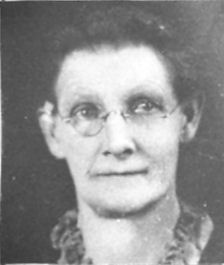
A few minutes later they reached the spot they were headed for. Lydia set Emma down in the shade of a tall sagebrush. Emma was able to look out over the valley below and could see they streets lined with houses, barns, and shops. Not far away, she could see the stone walls of the temple as they were going up. Her daddy worked in the quarry that cut the granite from the mountain that was used for the temple.
After a few minutes, Emma dozed off to sleep for a little while. When she woke up, her sisters had gathered a large pile of sagebrush and other wood. The sun was getting higher in the late morning sky as Lydia fastened a bundle of wood onto eight year old Martha's back. Six year old Sadie had helped gather the wood but was too little to carry a bundle back down the hill. Her job was to hold Emma's hand. With a bundle on her back and a large basket full in her arms, Lydia began leading the way back down the hill.
Before long, Emma's tired legs trudged into the yard where her mother, Sarah, was waiting for the girls to return. She had a large tub of water setting over the fire pit. All she needed to begin the laundry was the wood that she sent the girls after. Nine year old Henry had other chores that he was busy with. Sarah helped the girls unload their bundles and soon had a fire going. Lydia began fixing lunch, but for Emma and Sadie, it was time to play.
This may have been the way the day went that Emma recalled as as one of her first recollections. Emma Gover was born on November 19, 1864 in Salt Lake City, Utah. She was the daughter of Morris and Sarah Tucker Gover. They had joined the Church of Jesus Christ of Latter-day Saints in England in 1848 and had arrived in the Territory of Utah in 1853 with their daughter, Emily (June 18, 1850). Elijah (January 23, 1853) died the night before they sailed for America. Upon arrival in New Orleans, they made their way up the Mississippi River by side paddle river boat to Florence, Nebraska. They crossed the plains with assistance from the Church's Perpetual Emigration fund, and later paid the church one hundred dollars for their transportation.
Upon arrival in the Salt Lake Valley in the fall of 1853, the Gover's lived in the Tenth Ward and later moved to the Nineteenth Ward in Salt Lake City. Morris, who had been a coal miner in England, worked in the stone quarry in Big Cottonwood Canyon where the granite for the Salt Lake Temple was taken from.
While living in Salt Lake City, six more children were born. Lydia
(November 24, 1854), Henry Morris (December 20, 1857), Martha Ann
(March 24, 1860), Sarah, who went by Sadie (February 8, 1862), Emma,
who this story is about, (November 19, 1864), and Rosena (June 3,
1868). When Emma was just a year old her oldest sister, Emily,
married George Godfrey and established a home of her own.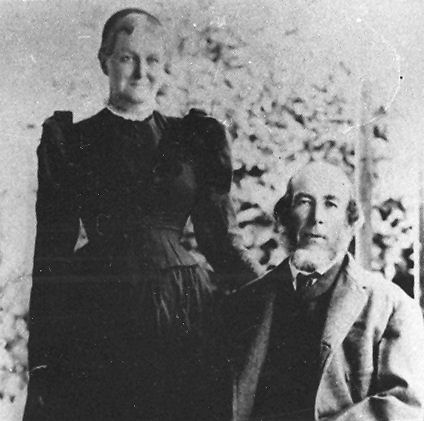
Sarah Tucker and Morris Gover
Some of Emma's first recollections were going with her mother and other family members to gather sagebrush on a hill north of the city. The trip was made once a week to get extra fuel for washday. This hill is probably in the vicinity of where the State Capitol Building is now located.
They saved the wood ashes in a barrel. To extract the lye from the ashes, water as poured over the ashes. The lye was used as a water softener for laundering. The lye was also mixed with meat scraps to make the soap used by the family.
Morris, Emma's father, did a lot of reading. He insisted that everyone should be very quiet. Emma recalls that she would get under the bed and play with her favorite kitten to keep quiet.
The first dresses that Emma remembered that she wore were dark blue denim skirts, with light colored waists (now called blouses) and front aprons tied around the waist. The waists and aprons were changed often and washed while the denim skirts could be worn much longer. The denim skirts could be worn several times before they needed to be washed.
A red calico dress was one of the highlights of her childhood clothes. She insisted on wearing it long after it was dirty. Her mother had gone with her father to Cache Valley to look over the possibilities of moving there. It became the strenuous task of her sister Lydia, to change the dress. After a game of Hide and Seek with the dress it was put up on some of the high rafters in the house, out of her reach. Emma said, "And did I cry something fierce."
Emma's first recollection of a bed was holes bored into the log walls of the house and posts set up to form a bed. Rawhide and later ropes were stretched across instead of springs. A bed tick stuffed with straw or cattails that had been burst open, served as a mattress.
Their home was lighted by candles made by Emma, her sisters, and her
mother. The candles were made from melted mutton tallow and set to
harden in molds.
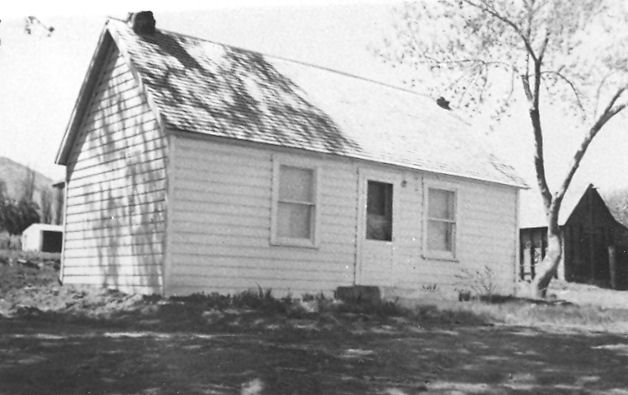
The Gover home in Clarkston. This home was built later on the same lot
as the as the onr room log cabin.
Emma was five years old when the family moved to Newton for a few months and then to Clarkston in 1869. Clarkston was first settled in fall of 1864, the same time Emma was born. A year later, her sister, Emily, and her husband and daughter also moved to Clarkston.
Their first home in Clarkston was a one-room log house. It did not have a ceiling in it, only rafters and a dirt roof. Morris bought a small farm with a house, a team of horses, and a wagon for employment for their son, Henry. Morris was in poor health as he had contracted ague fever while crossing the plains. (Ague fever is marked by chills, fever, and sweating in recurring regular intervals.)
Soon Emma was old enough to start school. The children only received as much education as their parents could pay for. Thus when the parents had a little money, the children were sent to school. When the money was used up, the children had to stay home. The children only received as much education as their parents could pay for.
School was held in three month terms. The pupils progressed by completing
readers, not by grades. They also furnished their own books, slates
and slate pencils. The desks were flat boards fastened to the walls
around the log room. The boards were on hinges so they could be
raised or let down. There were pegs to put into holes in the logs to
hold the flat board up. The seats were flat boards set on stumps. Art
was not encouraged in these pioneer schools. The children were
punished if they were caught drawing pictures.
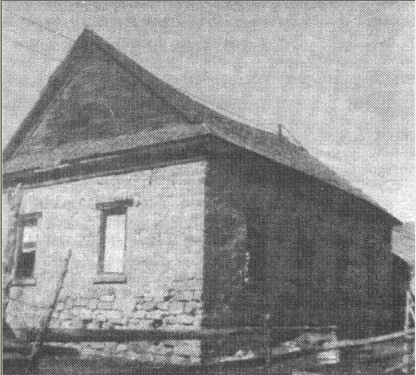
The old Clarkston Schoolhouse
At recess played ball or games like Run Sheep Run. (The rules to Run Sheep Run are on the last page of Emma's story.) Emma's closest friend was her niece, Ann Godfrey Sparks. Most of their clothes were made alike.
As Emma was eating a delicacy in later life, she said, "There wasn't much variety in the food we ate when Clarkston was first settled." It was homemade bread, potatoes, milk, mush, salted pork and mutton, and a few eggs of a poor grade because the chickens were left outside to hunt their own food. The fruit was dried peaches, plums, apples, and prunes. It was necessary to dry the fruit because glass jars weren't available then and refrigeration was an invention yet to be discovered. Molasses and honey were used as sweetening.
Emma was baptized in Clarkston On July 16, 1874 in Big Creek by Andrew Heggie Sr. and confirmed by Henry Stokes. She was re-baptized in October 1875, a year later, by her father Morris Gover and confirmed by Alfred Atkinson.
Mule drawn freight wagons used to pass through Clarkston on their way
north into Idaho and Montana. These freight wagons brought tragedy to
the Gover family. Emma's brother, Henry, and some of his friends
were sampling the the freighters beer by putting hollow wheat straws
into the kegs. Henry got some of the foam from the top of the keg.
Cobalt, which is a heavy metal, used to be added to beer to stabilize
the foam, but it can be poisonousness before the foam evaporates.
This caused his death on May 25, 1875 at the age of eighteen. After
Henry died, Morris sold the farm as he was not interested in farming.
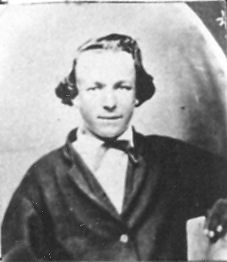
Henry Morris Gover
That was not a good year for the Gover family. They family came down with diphtheria and Sadie, who was fourteen, died from the disease on September 21, 1875.
The Young Ladies Retrenchment Society was organized in the Clarkston Ward on 5 March 1877 and Emma, at the age of twelve, was accepted into the Society at the first meeting. At that organizational meeting, the following resolutions were read and accepted by every member of the society;
Resolve that every member of the Association take an active part in all meetings.
That they set an example worthy of imitation in dressing becomingly and not follow after the ways and foolish fashions of the world. Also by engaging in the best and approved styles of dancing.
Resolve to keep the Word of Wisdom in every sense of the word and abstain from all hot and strong drinks and everything that is injurious to the system.
Resolve to consider it their duty as members to attend Sabbath meetings, Sunday School and other like places of mutual improvement.
Resolve to be more reserved in their actions and conversations and not indulge in loud laughter or disorderly behavior in meetings or social gatherings.
Resolve to keep good hours, that they cultivate a spirit of charity and not speak lightly of each other or sacred things.
At the end of the meeting, most everyone present made a few remarks and expressed a desire to help sustain the organization as a means of doing good. Shortly after it was organized in Clarkston, the Church changed the name to the Young Ladies' National Mutual Improvement Association.
The entertainment for the young people, Emma recalled, was sleigh riding
on homemade sleds, molasses candy pulls, and dances. The dances were
held about once a week and enjoyed by old and young alike. The stage
in the old rock-meeting house was usually filled with sleeping
children in beds made on the benches. The dances consisted of the
French Fours, Reels, Quadrille, and square dances. When the waltz was
first introduced it was called round dancing. Only one or two waltzes
were permitted each evening. The attendance at the dances was so
large that each man received a number when he bought his ticket. He
could only dance when his number was called.
The Rock Meetinghouse
Perhaps it was at one of these dances that Emma caught the eye of Daniel Buttars. Being a small community, everyone knew everyone else. At some point in time, Daniel and Emma became aware of each other. Awareness turned into interest, which lead to courtship, which resulted in marriage.
Daniel, Emma, and her mother made the trip to Salt Lake in a wagon drawn by a team of horses. It took them three days to drive from Clarkston to Salt Lake City. They stayed with friends and relatives along the way. Emma's mother accompanied them to see her daughter be married. While in Salt Lake, they were guests of the Cook family, who were relatives of the Govers. Daniel and Emma were married in the Endowment house on December 27, 1883 by Daniel H. Wells, who at the time was the Second Counselor in the First Presidency. At the time of their marriage, Daniel was twenty five and Emma had just turned nineteen.
Their first home in Clarkston was a one-room log house. Later they moved to
another home across the street.
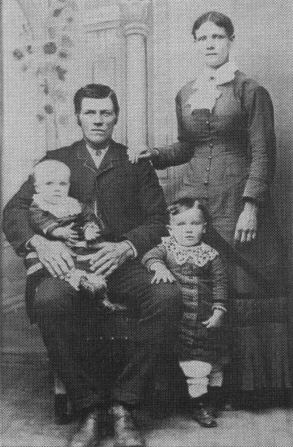
The Daniel and Emma Buttars Family -
About 1887. Daniel is holding Margaret,
Daniel David is standing in front of Emma
The land outside of town was available for homesteading. Daniel, being a stockman and a farmer, took every opportunity to improve himself financially. He moved his wife and family west of Clarkston on City Creek, where he homesteaded 160 acres of land. To homestead land, one had to live on the land at least six months of each year for five years. The land was covered with sagebrush, chokecherry bushes, and other trees. He worked hard clearing the trees and walking behind the hand plow and harrows to prepare the ground for planting grain.
Emma worked hard carrying water up a hill for about a block for the family's general use and for laundry purposes. She often walked the two miles to town, bringing her four children with her, carrying each of the younger ones as they became tired.
Her next home was located a farm that Daniel had received in a trade. The house had three rooms and an unfinished attic. The children reached their attic bedroom first by a ladder attached to the outside of the log house, later a platform and steps were installed inside.
All ten children were born in these small houses, six boys and four girls. Daniel and Emma were the parents of ten children; Daniel David (November 20, 1884), Margaret Sarah (August 25, 1886), Melvin Henry (December 23, 1888), Orson Morris (April 18, 1891), Maybell (May 3, 1893), Gover (December 10, 1895), Iraw (May 13, 1898), Hattie Bethea (November 17, 1900), Archulious (November 6, 1903), and Wallace Spaulding (July 25, 1906).
The only carpets they had at that time were made of strips of rags about one inch wide, which Emma sewed together and then wove into strips of carpet about twenty-seven inches wide. These strips were sewn in a shape to best fit the room. Each fall at thrashing time and in the spring these carpets were taken up and fresh clean straw was put under them to make the floor warmer and the carpet last longer.
The bed ticks were also stuffed with straw and changed regularly. Feathers replaced the straw as soon as enough feathers had been accumulated. A white gathered curtain that reached to the floor was placed around the bed (a bolster), and one long pillow that reached across the head of the bed was used. The bolster was stuffed with chicken or duck feathers.
Another task that came more regularly than changing the straw was
white washing the walls and ceilings of the house. Lime mixed water
was used and applied with a brush, much the same as we use paint
today. Emma said, "Quite often I would just get my white washing
done and a rainstorm would come and spoil it. We had about a foot of
dirt on the roof instead of shingles so if the rain lasted very long,
it would wash some of the dirt through on my clean ceiling and
walls".
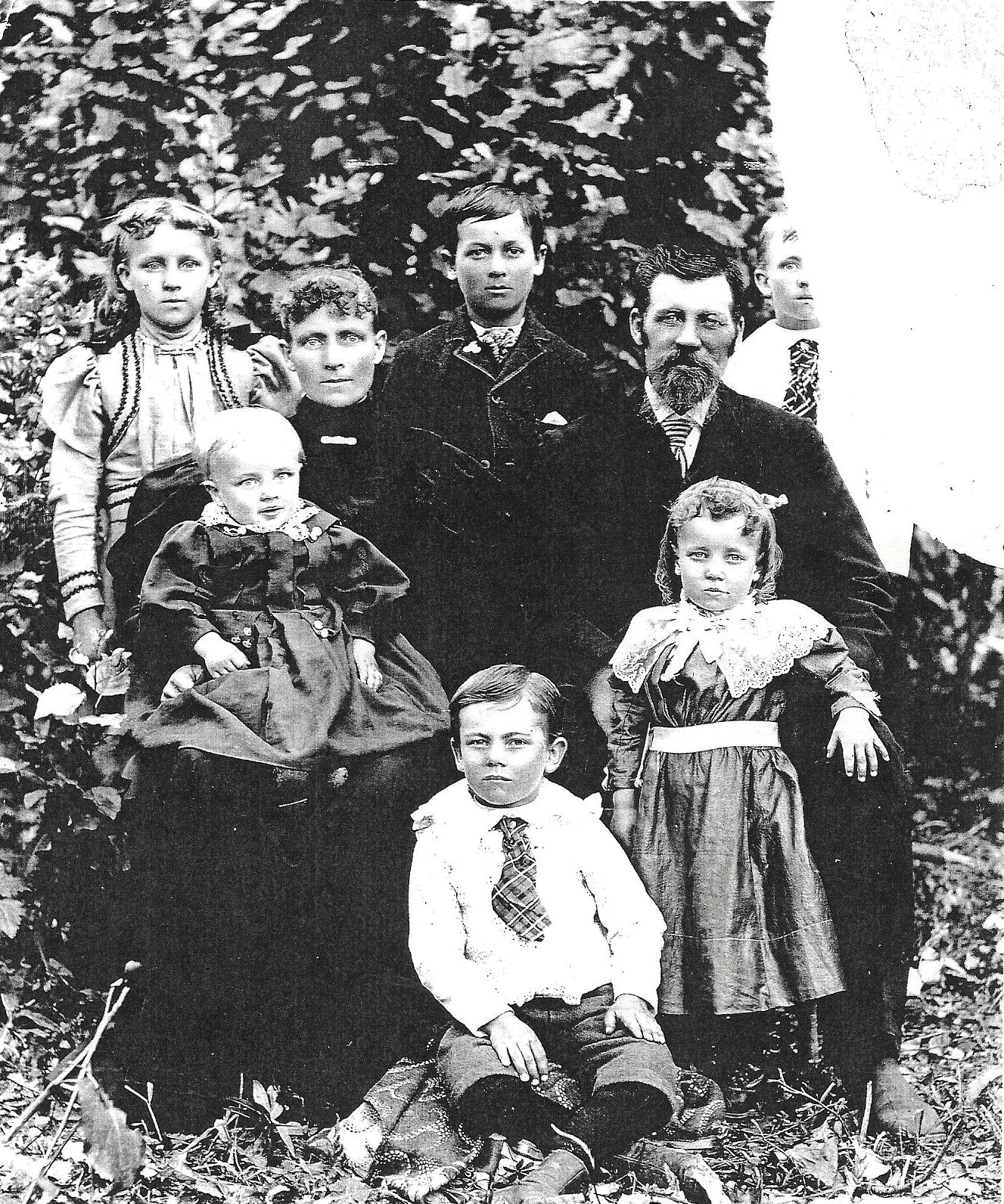
The Daniel and Emma's family in about 1896.
Standing in the back are Margaret, Daniel David,
and Melvin. Seated are Emma holding Gover, and
Daniel. In the front are Orson and Maybell.
Knitting stockings for the family was a steady job for Emma. Fathers, mothers and all of the town children wore them. They were made of black or gray yarn for the adults and white for the babies. The younger members of the family did not wear them many years as stockings were then made commercially and bought in the stores.
Emma first washed on a washboard for her large family and for one or two hired men. Washday usually lasted all day for her. The first improvement was a western washer. The one who operated it stood up and pushed a wooden handle, which was about two feet long, over and back in a half circle. This motion on the top of the lid motivated the dolly inside the tub.
Washers improved after time. The next washing machine she had, had a handle on the side of the tub which was pushed forward then pulled backward to power the gears that turned the agitator. The next improvement featured a washing machine with a wheel on the outside of the tub. The operator could sit down to turn the wheel that powered the agitator. Eventually, a belt running from a water powered motor was attached to the wheel, freeing the operator from turning the wheel by hand.
All of the ironing was done with stove irons. A stove iron was a piece of iron weighing about three pounds. It was fashioned into an iron similar in shape to the modern iron. These irons were set on a stove, which was heated by coal, wood or in early days sagebrush to get hot. The handles also got hot so it was necessary to use a pad to protect the hand.
Emma and Daniel cured their own meat by either dry salting or a brine and
smoking. To smoke the meat a cellar was dug in the ground or a small
airtight building made. The pork was hung from the ceiling. A slow,
smoldering, smoking fire made of apple tree wood was kept burning for
a few days. This gave the meat a delicious smoked flavor. They also
made sausage, headcheese and beef jerky. Cutting the meat into strips
made the jerky. It was then put into salt brine for about two weeks.
Then it was hung in the sun to dry. Richard Godfrey would kill a beef
the day before some special occasion and everyone would come to buy
some fresh meat for a much-needed change.
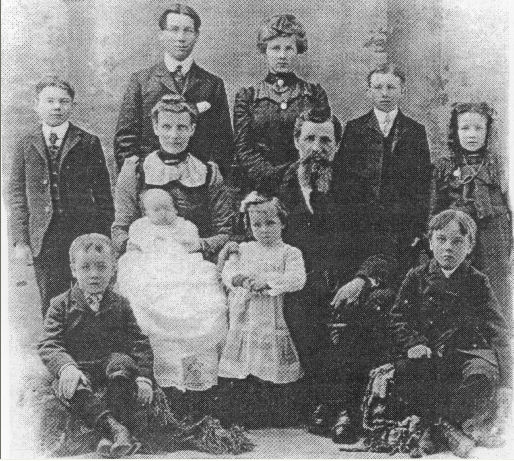
Daniel and Emma Buttars Family - about 1904 Standing; Orson, Danny,
Margaret, Melvin, and Maybell. Seated: Gover, Emma holding Archulious,
Daniel with Hattie, and Iraw.
By the time the youngest was born, the older children had grown up. Danny married Margaret Kent on June 19, 1906. Margaret married James H. Jardine on April 17, 1907. Melvin served a mission in New Zealand from October 1, 1910 until December 20, 1912.
On the same day that Wallace was born, work began on a large house located on the same property as the home they were living in at the time. The contractors worked on it all of that summer and the next. All of the material to build the house was hauled from Logan by horse drawn wagons. The rocks for the foundation were hauled from the surrounding area. The house was completed in 1907 and the family moved in for Christmas.
The new, two story house featured indoor plumbing which included a kitchen sink, bathtub, and toilet. There was not yet a central water system in Clarkston. To supply water for the house, a five hundred gallon water tank was installed on the second floor. It took about an hour and half each morning to fill the tank with a hand pump. The tank generally lasted through the day. It was the first house in Clarkston with a bathtub and a toilet in it. Many people came from all over just to see it.
At first, kerosene lamps were used to light the eight rooms until about
1913, when gas lights were installed. A tank supplied the gas. The
lights were pressurized by a hand pump. The gas lights were not very
successful and were dangerous. When electricity came to Clarkston in
1916, it was quite a chore to wire the the two story house.

The Daniel and Emma Buttars home
The kitchen, dining room, parlor, and two bedrooms were on the main floor. A beautiful hand carved banister graced the stairs that led to five more bedrooms on the top floor. All new furniture, tables, chairs, beds, window curtains, blinds, etc. were purchased for the new home.
Daniel was very hospitable – at Emma's expense. Everyone who came along were invited to come in for dinner or even spend the night. The smaller children were often put to bed on the floor, so the guests could occupy their beds. Their horses were also taken care of. In fact, so many people stayed there that their home was referred to as The Mountain View Hotel. One had only to look out the back door to see the the beautiful mountains to the west, especially at sunset to appreciate the name.
Emma said later, "If I could have had this electric stove and been able to go to the store and buy a loaf of bread like I can now, instead of having to make soda or baking powder biscuits each time company came and my bread supply was low, it would have been easier."
Eight loaves of bread and a big pan of biscuits were mixed and baked every day. During the haying and the harvesting season when there was extra hired help, this same amount was baked twice each day.
Emma was a wonderful homemaker. She was clean and particular in every detail. Her home was decorated with her own handiwork. Beautiful patchwork quilts and fancy pillowslips were on the beds. Braided and crocheted throw rugs were on the floors. Doilies were on every cupboard shelf, and there were embroidered tablecloths and comfortable chair back covers. She could knit, crochet, embroider, and do tatting. She did this kind of handwork until she was eighty-five years old.
Daniel served on the the city council in 1910 and 1911. He was a great man for the people of Clarkston. He was a real financier both for the people and himself. Things always seemed to come his way. He was involved in several projects that improved the life in Clarkston for everyone.
The big two story house began to empty out by 1914, as more of the
children went out on their own. Melvin, who had returned from his
mission in 1912, married Agnes Jardine on January 7, 1914. Maybell
married John H. Griffiths on January 28, 1914. And Orson married
Elva Layne on June 17th of that same year. There was only one wedding
in the family during 1915. On November 23rd Gover married Mary Elza
Godfrey. (Mary was the granddaughter of Emma's sister, Emily.)
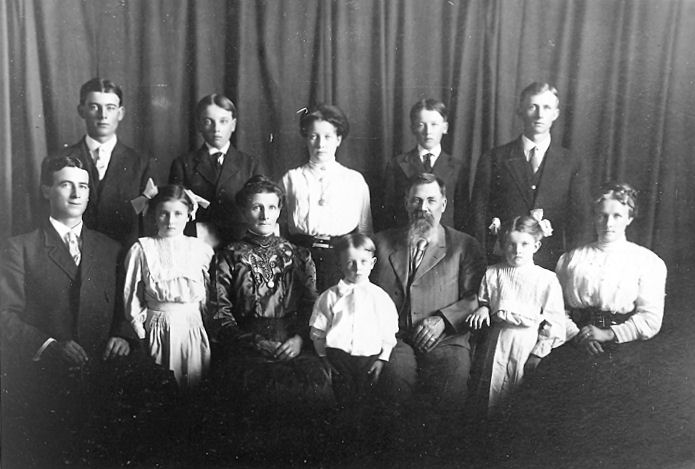
The Daniel Buttars Family Front row: Danny, Hattie, Emma, Wallace,
Daniel, Archulious, and Margaret. Back row: Orson, Gover, Maybell,
Iraw, and Melvin.
Daniel died very suddenly of a heart attack about five am on January 10, 1916. He was sitting in his big leather chair in front of the Heatrola. He slipped out onto the floor. He and Emma were the only ones up that early but it didn't take the rest long to get up when Emma called for help. There was a lot of snow that winter so horses and a sleigh were used in the funeral cortège. The casket was placed in the sleigh and covered with a quilt. Spring seats and boards were placed across the other sleigh boxes for the family and friends to sit on. He was buried in the Clarkston Cemetery.
Emma was only fifty-two years old at this time and there were four children between nine and eighteen years old who were not married. Her husband had always taken care of all the financial and business affairs himself, but Emma soon learned by experience and became very efficient in farm management. Emma was a widow for thirty-six years, three years longer than she lived with her husband.
When Emma's mother became too old to live alone, she spent part of
her time with Emma. She was living there when she died on February
15, 1917, just thirteen months after Emma's husband's death. Emma was
very kind and thoughtful of her mother. She also insisted that her
children treat her very respectfully.
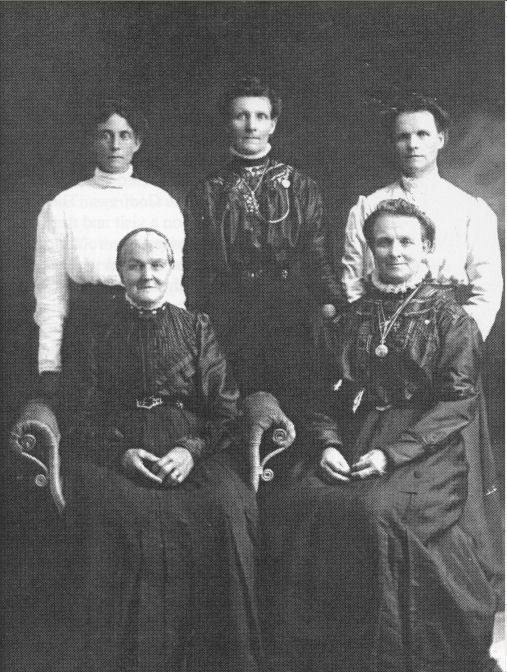
The Gover Women. Standing: Rosena, Emma, and
Martha. Seated: Sarah Tucker Gover, and Lydia
Her son Gover with his three children, Ervin, Gordon, and Milton lived with Emma for two years after his wife, Mary Godfrey Buttars died. Milton, who was born the day of his mother's death, lived with Emma until he was eight years old. He always called her mother. She missed him very much when he went to Burley to live with his father. Emma said, "I thoroughly enjoyed raising Milton. I had so many modem conveniences and more time to enjoy him than I did my own children."
One of Emma's church activities was working on the Old Folks committee with her husband, before his death, along with four other couples. The ward did not have any dishes at the time so it was necessary for the committee to bring enough of their own dishes and silverware to serve the meals.
She was first counselor in the Primary for many years and later was the president. At another time she served as Counselor in the Relief Society Presidency. She also served as a Visiting Teacher and a teacher in the Sunday School.
Emma moved to Logan for two winters to work in the temple, usually attending three sessions each day. She also spent several hundred dollars on genealogical research and hiring names done. She got very homesick those two winters.
Emma enjoyed a trip she took to Los Angles, California, in December 1924
with her daughter-in-law, Maggie Buttars, Elizabeth Layne, and Hannah
Blair. Some other places she visited were Yellowstone Park, Salt Lake
City for conferences and other church organization conventions, Bear
Lake, Burley, and Teton, Idaho. Her desire to visit England where her
parents were born was never fulfilled. 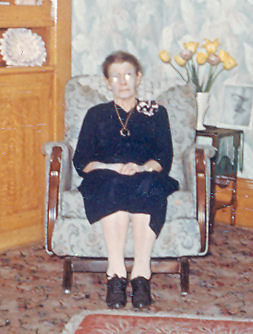
Grandma Emma Buttars toward the
end of her life.
Emma's last illness began on March 21, 1951 when she had a serious heart attack. She wanted to stay in her own home, so her four daughters and Wallace took turns staying with her. Several other heart attacks followed. She passed away July 1, 1952 at the age of eighty-seven. Funeral services were held on July 5th and internment was in the Clarkston cemetery, next to Daniel.
She had a large posterity at the time of her death. Seven children, forty five grandchildren, seventy eight great-grandchildren, and two great-great-grandchildren living. Three sons (Daniel David, February 21, 1944; Orson Morris, July 11, 1951; and Iraw, 20 Jun 1957), seven grandchildren, and one great-grandchild had preceded her in death.
The main source for this biography was the “History of the Life of Emma Gover Buttars” written by Archulious B. Archibald and from “Clarkston: The Granary of Cache Valley”. The hillside story was made up to introduce Emma.
How to Play Run Sheep Run
Set up a “sheep pen” and a “fox den.” These are simply two areas on opposite sides of the playing area.
Mark boundaries clearly, letting kids know how far they can go for both the hiding (for the sheep) and the searching (for the foxes).
Divide everyone into two groups: one group of sheep and one group of foxes. Explain that they will trade roles later.
Tell the sheep to choose someone who will be the “Old Ram.” This player makes decisions for all the sheep and tells them where they will run and hide. They must all stay together for the entire game.
Meanwhile, the foxes choose the “Fox King.” He (or she) will make the decisions for all the foxes. The foxes cannot begin looking for the sheep until the Old Ram comes to get them.
After the sheep are hidden, the Old Ram reports to the foxes and tells them, “My sheep are hiding; you will never find them.”
The foxes take off, led by the Fox King, looking for the sheep. They must stay together for the entire game.
The Old Ram runs with the foxes, and when he (or she) thinks the sheep would have a good chance to make it back to the sheep pen without being caught by the foxes, he yells out, “Run, Sheep, Run.”
Both the foxes and the sheep then race to the sheep pen. If the sheep get their first, they get to be the foxes next. Otherwise they must continue to be the sheep.
The game is won when one group has been the foxes for three consecutive times.
You might want to have a new “Old Ram” and “Fox King” chosen for each round to give several kids the chance to serve as the leader.